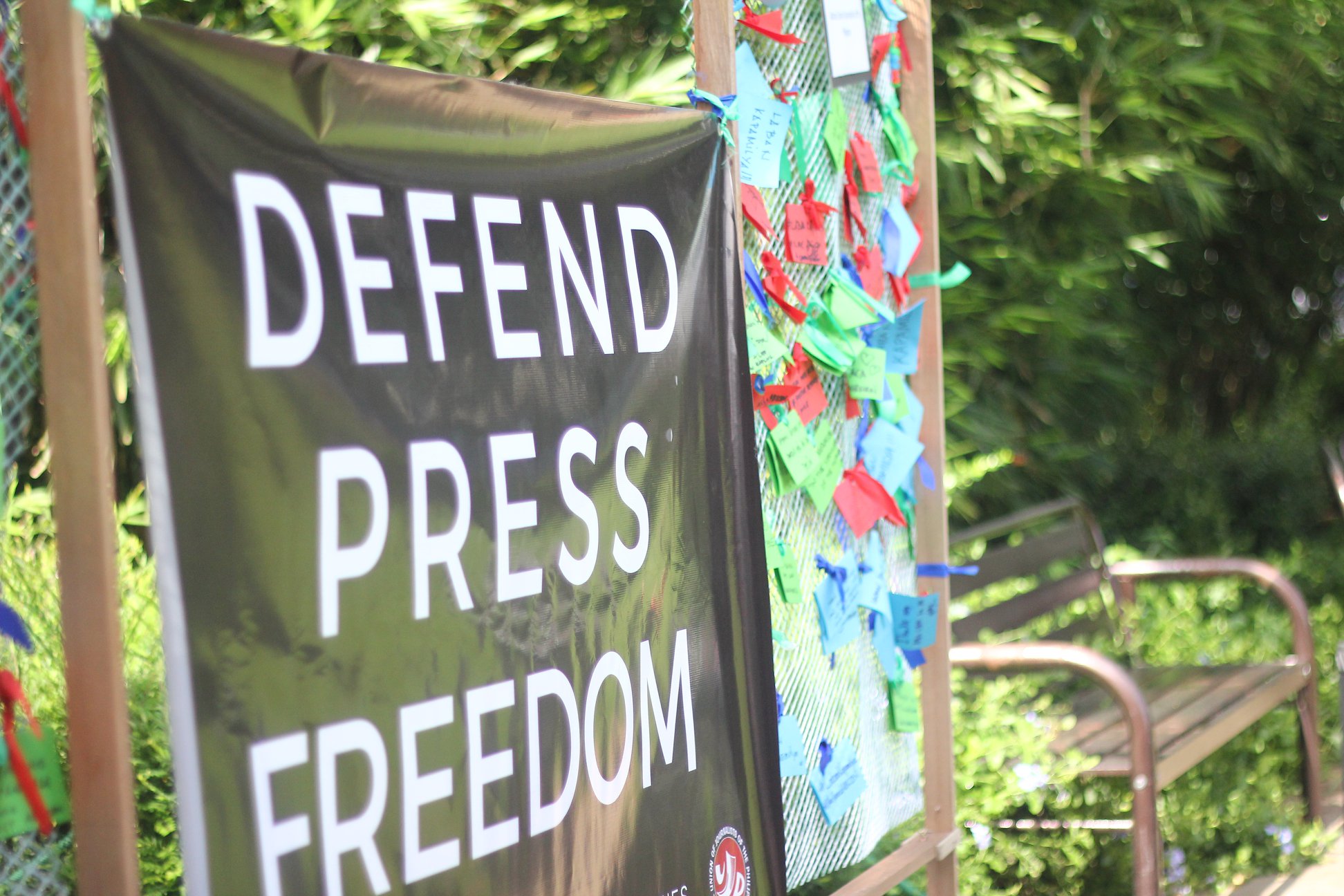Photo by Bulatlat
To commemorate Human Rights Day, we are releasing a series of articles highlighting the worsening rights situation in the Philippines under the Duterte regime. These will be compiled with a dozen similar articles and published as a book in January 2021. We are grateful to the contributions of people’s organisations and civil society.
By Janess Ann J. Ellao, Ronalyn V. Olea and Anne Marxe D. Umil / Bulatlat
The Anti-Terrorism Act of 2020 has been widely criticised for curtailing press freedom and the freedom of expression. It has granted authorities the power to detain activists and journalists, and to allege them at the very least of committing terrorism as the law so vaguely defined.
In December 2019, a Philippine court has rendered a historic decision that convicted a political clan and their cohorts guilty of the infamous Ampatuan massacre[i], the single deadliest attack against journalists. This has made the Philippines as the “biggest mover” and has put it in the top five deadliest countries for journalists[ii], per the Committee to Protect Journalists.
On the ground, however, the situation remains very much terrible, with over 19 journalists killed and scores more harassed and subjected to trumped-up charges under the Duterte administration.
The raging pandemic has made it even worse. If at all, Murray Hiebert[iii], a Southeast Asia expert at the Center for Strategic and International Studies in Washington, said that controlling the local transmission of the dreaded virus is the “perfect cover” for an authoritarian ruler’s “draconian levers to rein in their opponents and critics.”
The Philippine media, both those belonging to the dominant and alternative media tradition, has made its COVID-19 coverage a priority. The uncertainties and deluge of unverified information have posed challenges for journalists both here and abroad on the truthfulness of their reports. Still, journalists have continued to provide the public with information they need to make sense of what is happening, and in striking down the widespread disinformation later referred to as “massive infodemic.”
This has changed many aspects of a Filipino journalist’s work, from the protective gear to wear and minimum health standards to observe, and even the process of news gathering. Conducting interviews and covering of press briefings have primarily moved to the digital space, with Zoom, Jitsi, and Google Meet as among the commonly used teleconferencing applications. Social media platforms have become even more a tool for news gathering.
It has, too, altered how we do journalism – from news gathering to how our intended audiences consume them, to name a few. Media institutions have scrambled to set up home-working systems and embraced multiple online communication platforms in an effort to “create a parallel and secure virtual office world.”
But in the middle of a pandemic, the Philippine government had other priorities in mind. President Rodrigo Duterte, four months into the lockdown, signed into law the controversial Anti-Terrorism Act of 2020, which is currently one of the most challenged laws before the Supreme Court.
The law and its many contentious provisions have been widely criticised for curtailing press freedom and the freedom of expression. It has granted authorities the power to detain activists and journalists, and to allege them at the very least of committing terrorism as the law so vaguely defined.
On top of the threats posed by the pandemic and the terror law, the state of the Philippine media is currently at its worst since the Marcos dictatorship. Journalists have found themselves at the receiving end of hate speech, particularly on various social media platforms, as they are tagged as paid, “presstitutes”, communists, and worse, vilified as terrorists.
On top of the threats posed by the pandemic and the terror law, the state of the Philippine media is currently at its worst since the Marcos dictatorship.
Discrediting the media
Since the Duterte administration was ushered into power, journalists have been vilified as “fake news,” “spies,” “prostitutes[iv],” said Yvonne Chua of the University of the Philippines.
Several media outfits and journalists have been named as part of the infamous “matrix” that supposedly sought the ousting of President Duterte. This has been dismissed by the Philippine Center for Investigative Journalism, one of the media outfits named in the matrix, as “wrong on many points[v].”
While the Duterte administration has been infamously known for his attacks against the press, it is the community journalists, particularly those covering the human rights situation on the ground, who are at the receiving end of more vicious forms of intimidation and harassment.
Vilification and red-tagging campaigns usually precede graver forms of abuses against journalists, advocates, and human rights defenders. Such tactic attempts to discredit the work of the media, with the end goal of controlling public opinion.
Apart from the posters that are put up on the streets, red-tagging is also prevalent online, with government-backed Facebook Pages that spread Internet memes on the supposed link of progressive groups and alternative news websites to the armed struggle. Local and international human rights groups and organisations have long pointed out that red-tagging is usually a prelude to graver human rights abuses such as arrests, filing of false charges, and even enforced disappearances and killings.
Vilification against journalists and media outfits, both in the dominant and alternative tradition, sends a chilling effect and hampers their duty of searching for truth. Several community journalists have been turned down by interviewees who are afraid of reprisals from state forces, or have been kept from official government briefings.[vi]
Some of those red-tagged have been compelled to leave their communities as a matter of safety precaution. This has directly impaired the capacity of these media outfits in reporting stories from the ground.
In Eastern Visayas, community journalist Frenchie Mae Cumpio was arrested on February 7, 2020 and jailed over charges of illegal possession of firearms and explosives. She was labelled as a high-ranking officer of the Communist Party of the Philippines. A fact-finding mission revealed that the firearms and explosives were planted. As of this writing, Cumpio remains in jail in Tacloban City.
Vilification and red-tagging campaigns usually precede graver forms of abuses against journalists, advocates, and human rights defenders. Such tactic attempts to discredit the work of the media, with the end goal of controlling public opinion. Vilification against journalists and media outfits sends a chilling effect and hampers their duty of searching for truth.
| The case of community journalist Frenchie Mae Cumpio |
|---|
| Frenchie Mae Cumpio is the executive director of online media outfit and regular anchor of Lingganay han Kamatuoran aired at Aksyon Radyo Tacloban. On February 7, 2020, joint elements of the police and military raided Eastern Vista’s office in Tacloban City and arrested Cumpio and four development workers and rights defenders. The Philippine Army’s 8th Infantry Division claimed that Cumpio is a high-ranking officer of the Communist Part of the Philippines (CPP). She was charged withillegal possession of firearms and explosives. A fact-finding mission revealed that the firearms and explosives used as evidence were planted by the raiding team. Several local and international media watchdogs have called for the release of Cumpio. She remains in detention in Tacloban City. In 2019, Cumpio reported she had been tailed by suspected state agents as she consistently reported about the human rights abuses in Eastern Visayas region. |
Digital attacks
In December 2018, progressive online news became inaccessible to its readers. Through digital rights activists both here and abroad, Bulatlat later learned that their website, along with several other alternative news, was subjected to one of the biggest Distributed Denial of Service (DDoS) attacks ever recorded in the world.
DDoS refers to the malicious and deliberate attempt to shut down a website by overwhelming it with a flood of internet traffic[i].
Attackers had the plan carefully laid out, as it initially kept their requests at a low ratio to avoid flood detection. One of its worst attacks was on January 29, 2019 where they flooded the website with three million packets of second for 60 minutes. In simple language, nearly half a year of traffic has been reduced to a mere second[ii].
As a result, the website had become inaccessible to its readers.
The Baguio-based Northern Dispatch was also subjected to DDoS attacks, amid its reporting on the government response to the pandemic, while at the same time showcasing the relief operations and other services of people’s organisations for the poor and vulnerable sectors. Prior to the DDoS, Northern Dispatch and its writers and editors have long been subjected to red-tagging.
Online news Bulatlat has noted in its Digital Security Policy and Guidelines for Filipino Journalists (2020) how internet trolls swamp the comments sections of stories on human rights violations, press freedom, and the controversial terror law to peddle disinformation and false narratives. The Philippine government’s involvement on these Pages have been proven when Facebook itself took down several for its inauthentic coordinated behaviour.
Physical attacks, trumped-up cases
Since 1986, when democracy has been purportedly restored, nearly 200 journalists have been killed. Of these, only four have led to a conviction.
These online attacks have also translated to physical harm, in an attempt to muzzle the Philippine press from reporting the real situation on the ground.
Since 1986, when democracy has been purportedly restored, nearly 200 journalists have been killed. Of these, only four have led to a conviction, which, the NUJP said[iii], is worse than the United Nations’ pronouncement that only one of 10 media killings over the past decade has led to conviction.
The Philippines has its own share of heightened media repression amid the pandemic. Even the United Nations Special Rapporteur on the Promotion and Protection of the Right to Freedom of Opinion and Expression[iv]said that “people have suffered because some governments would rather protect themselves from criticism than allow people to share information, learn about the outbreak, know what officials are or are not doing to protect them.”
During the pandemic, the Philippine government has ordered the shutting down of one of the country’s media giants ABS-CBN. A local court also rendered a guilty verdict against Rappler’s chief Maria Ressa and their former researcher Reynaldo Santos Jr. for cyberlibel charges. Apart from the two, at least a dozen more journalists have been charged with cyberlibel, mostly by politicians, according to the NUJP.
Other charges have also been filed against news outfits covering the absence of social protection provided to those affected by the pandemic. Community radio Radyo Natin Guimba was charged for allegedly violating lockdown restrictions[v], following their consistent reporting on the slow distribution of aid in Guimba town, in Nueva Ecija, Central Luzon.
In several instances during the lockdown, policemen confiscated copies of alternative magazine Pinoy Weekly. A regional police officer claimed that Pinoy Weekly contained “subversive material,” justifying the confiscation as “a matter of national security.”
But the worst form of censorship is when journalists themselves are being killed.
The most recent incident is the case of Ronnie Villamor, who was shot dead by the Philippine military[vi]in an alleged encounter on November 14, 2020. Four days earlier, another was also shot dead. For both counts, as in most media killings in the country, no proper, thorough, and independent probe has ever been conducted.
Meanwhile, the community press is bearing the brunt of the government’s attempt at stifling the media. The alternative press has been subjected to increased red-tagging – among the most recent was the inclusion of AlterMidya and its member media outfits in the list of supposed fronts of the revolutionary movement in a Senate hearing on December 1, 2020.
AlterMidya, a network of all alternative news agencies in the Philippines, deplored the red-tagging, saying that it is an irresponsible practice, “which is in stark contrast to our ethical commitment of truthful and careful reporting as journalists.”
Fighting back
Hope lies in the continuous assertion of the right to free press and free expression. These rights are not exclusive to journalists and media workers but are inherent rights of all citizens. Amid the pandemic and the rising tyranny, the Filipino people all the more need truthful information which they can use in their decision-making.
Despite the attacks, the Philippine media continues to be robust in its truth telling.
Many journalists in the corporate media remain critical in their reporting while alternative media practitioners continue to provide reports that are often neglected or underreported in the dominant media.
Filipino journalists are also taking all the necessary steps to ensure their safety. Training sessions on physical and digital safety have been conducted by several press freedom advocacy organisations.
Media outfits also exhausted legal remedies as part of the campaign to defend press freedom. In 2019, Bulatlat, Altermidya, Kodao Productions and Pinoy Weekly won the civil case filed against IT companies over the cyber-attacks.
Alternative media outfits also filed complaints before the Commission on Human Rights against state security forces and public officials who red-tagged them
ABS-CBN supporters initiated the Pirma Kapamilya, a people’s initiative to bring the network back on air.
Hope lies in the continuous assertion of the right to free press and free expression. These rights are not exclusive to journalists and media workers but are inherent rights of all citizens. Amid the pandemic and the rising tyranny, the Filipino people all the more need truthful information which they can use in their decision-making.
Time and again, the media’s role is to serve as a watchdog of wrongdoings especially by those in power. During periods of crisis in the Philippine history, such role proved vital in the fight against anti-people governance and repression.
Bulatlat as well as other members of the alternative media will continue its journalism for the people. The struggles of the marginalised and the oppressed have not ended, and our work of amplifying their voices is all the more needed in this time of tyranny.###
[i] Cloudflare. What is a DDoS attack? https://www.cloudflare.com/learning/ddos/what-is-a-ddos-attack/
[ii] Bulatlat (2019). What you need to know about the ongoing cyber-attacks vs. alternative news Bulatlat. Published by Bulatlat.https://www.bulatlat.com/2019/02/07/what-you-need-to-know-about-the-ongoing-cyber-attacks-vs-alternative-news-bulatlat/
[iii] NUJP (2020). Persistent impunity is society’s, not just media’s, loss. https://nujp.org/statement/statement-persistent-impunity-is-societys-not-just-medias-loss/
[iv] Kaye, D. (2020) Disease pandemics and the freedom of opinion and expression. Published by the UN General Assembly. https://undocs.org/A/HRC/44/49
[v] Villanueva R. (2020). For reporting slow aid distribution, radio station in N. Ecija threatened by local officials. Published by Bulatlat. https://www.bulatlat.com/2020/05/21/for-reporting-slow-aid-distribution-radio-station-in-n-ecija-threatened-by-local-officials/
[vi] International Federation of Journalists (2020). Philippines: Journalist shot dead by soldiers. https://www.ifj.org/media-centre/news/detail/category/press-releases/article/philippines-journalist-shot-dead-by-soldiers.html
[i] Olea, R. (2019) Court finds Andal Ampatuan et al. Guilty. Published by Bulatlat. https://www.bulatlat.com/2019/12/19/court-finds-ampatuans-guilty/
[ii] Beiser, E. (2020) CPJ’s 2020 Global Impunity Index spotlights countries where journalists are slain and their killers go free. Published by the Committee to Protect Journalists. https://cpj.org/reports/2020/10/global-impunity-index-journalist-murders/
[iii] Barron L. (2020) It’s Not Just Maria Ressa’s Arrest. Coronavirus Is Accelerating Crackdowns on Press Freedom Across Asia. Published by Time.com. https://time.com/5858487/coronavirus-asia-press-freedom-maria-ressa/
[iv] Chua, Y. (2020) Digital News Report on the Philippines. https://www.digitalnewsreport.org/survey/2020/philippines-2020/
[v] Gonzales, C. (2019). Journalists, lawyers in ‘ouster plot matrix’ may face cases — PNP chief. Published by Philippine Daily Inquirer. https://newsinfo.inquirer.net/1109701/journalists-lawyers-in-ouster-plot-matrix-may-face-cases-pnp-chief
[vi] Ellao et. al. (2020). Digital Security Policy and Guidelines for Filipino Journalists. Published by Bulatlat.



